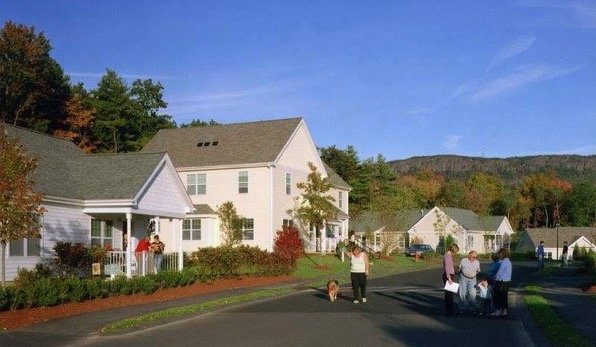Guilderland to get first proposal for intergenerational housing
— Photo from the Facebook page of the Treehouse Foundation
The Beacon Communities project to be proposed soon at Mercy Care Lane in Guilderland is an intergenerational project that would pair mostly independent-living senior apartments with a small number of families who have adopted foster children.
GUILDERLAND — An intergenerational apartment complex will soon be proposed for Mercy Care Lane that would have 64 units, housing families adopting foster children, housing young adults with disabilities, and housing residents aged 55 and older. The apartments would vary in price from affordable to people with low incomes through moderate to market-rate.
Mercy Care Lane is off of Route 20, Guilderland’s main thoroughfare, near the public library. The development would be visible from both Mercy Care and Winding Brook Drive, said Kenneth Kovalchik, Guilderland’s town planner. Winding Brook Drive has a YMCA facility and is the site of proposed apartment complexes.
The site for the intergenerational housing is in an area zoned R15, or residential with a minimum lot size of 15,000 square feet. The category of “residential facility, independent-living” is allowed there with a special-use permit, under Guilderland’s zoning code. Kovalchik said the zoning board will be the lead agency, with the planning board responsible for reviewing the site plan and making a recommendation to the zoning board.
The idea is that children from the foster-care system and older adults will benefit from offering social support to each other, said Yael Petretti, volunteer coordinator for the not-for-profit Treehouse Foundation in Easthampton, Massachusetts, which has been in existence for 12 years and is the model for the proposed Guilderland community. Easthampton is a city with a population of about 16,000 — just under half of Guilderland’s population — near the college towns of Northampton and Amherst.
In Easthampton, Petretti said, the elderly residents of the community — often called “elders” — serve as “honorary grandparents” to the young people, and are asked, but not obligated, to volunteer if possible with things such as moral support, after-school tutoring, or driving children to doctors’ appointments when parents are working.
“They get a lot out of it,” said Petretti of the senior-citizen residents, “and feel more useful.”
She continued, “These folks have almost a new lease on life. The kids really need them, and they need the kids, too.” She described the community as “kind of like the extended family of old. We’ve kind of lost that, and we’re poorer for it.”
Treehouse checks with parents to ask if they would like a particular resident to drive their children to an appointment, Petretti said, adding the community is relationship-based, as in any development. “There are people that you like and are drawn to; that’s how communities are formed,” she said.
The impetus for the Guilderland community came from the New York State Office of Children and Family Services, which consulted with Treehouse Foundation before approaching Beacon Communities to ask it to create the first example of this model in New York State. OCFS is also in conversations with Beacon about starting a community in Binghamton, but that project is in early stages, according to Monica Mahaffey, a spokeswoman for the state agency.
Treehouse Foundation served as the inspiration, but is not involved in the complex to be proposed in Guilderland.
Mahaffey wrote in an email to The Enterprise, “OCFS supports a community model where foster families, elders, and individuals with developmental disabilities are engaged and supportive of each other in their own neighborhood. This model has improved the lives of foster children with higher school graduation rates, reduced involvement in the criminal justice system, fewer incidences of early parenting, and more stable foster care placements. OCFS looks forward to further exploration of this model with Beacon Communities and the Town of Guilderland.”

The plan
Beacon Communities hopes to submit a proposal to the town in December, according to Duncan Barrett, president of Beacon Communities Development LLC - New York.
Beacon plans to propose a 64-unit apartment complex of bungalow-style homes with one- and two-bedroom apartments, on an 11-acre property, he said. The density per acre, he said, is probably more than with most single-family homes, but low for apartments.
There would also be a community center, said Kovalchik.
“Our real intent is to demonstrate that this concept can be utilized and that it will be successful in New York State,” Barrett said of the project.
“This is a community where we are telling people up front that you are encouraged to get to know your neighbors,” Barrett said. So residents will tend to self-select, he said, because there are many senior-only communities that people can choose.
Fifty-two units, or 80 percent, would be age-restricted, Barrett said, for people aged 55 and older.
Six would be for families who have adopted or are committed to adopting children from the foster-care system. “The adoption process for this population can be time-consuming and complicated,” he said.
Another six units would be for young adults with disabilities who are able to live on their own, Barrett said, adding that the Office of Children and Family Services wanted to include that population in this project. Asked about the preference for “young” adults with disabilities, Barrett said that the project would not engage in any discriminatory practices, but said that OCFS and the not-for-profit partner indicated that they wanted this population to be targeted in this project, so the initial marketing and referrals for those six units will probably focus on that population.
“They’ve been in the care of parents, and they’re ready to live independently but can’t live independently without some kind of case-worker services to help them expand their life skills in the world,” Barrett said of young adults with disabilities.
Northern Rivers will provide case management and social-service support for adoptive families, and the Center for Disability Services will also provide the same kind of support for the adults with disabilities, said Barrett. The community as a whole will have a residential-service coordinator to provide a layer of service, he said.
The composition of units is very similar to Treehouse in Easthampton, which has 52 age-restricted units and 12 units for families of adoptive or foster children. In Guilderland, the 12 units would be split equally among adoptive families and young adults with disabilities.
“It isn’t very many,” Barrett said of the 64 total units. “If you built a large complex, you would run the risk of not forming a collegial community of support.”
Results achieved by children at Treehouse in Easthampton have been “fabulous” compared to national averages for foster youth, Barrett said. He provided a table of figures that compared these two groups over the period 2006 to 2007.
These included a near-doubled rate of high-school graduation, from 58 percent nationally to 95 percent at Treehouse; a rate of attending college or vocational school of less than 10 percent nationally compared to 100 percent at Treehouse; and incidence of arrests at 46 percent nationally compared to 0 at Treehouse.
Barrett declined to send a site plan or elevation, until the project is formally proposed to the town.
Choice of location
Beacon looked at a number of sites and became interested in land on Mercy Care Lane because it is walkable to the public library and the YMCA and has access to public transportation, Barrett said.
The company does not now own the land, but has it under contract.
“We have not yet formally made this proposal to the town yet, and we know there is concern about the rate of development in Guilderland,” he said.
When Beacon started this project, it was not aware of the other proposed projects along nearby Winding Brook Drive, Barrett said, adding, “But now we are.”
He said of the project, “We’re very modest traffic generators.”
Fewer than 10 children are likely to live in the community, and not all of them would necessarily attend Guilderland schools, Barrett said. He has been told by the Office of Children and Family Services that those in foster care might continue to attend their home schools, for the sake of continuity, he said.



